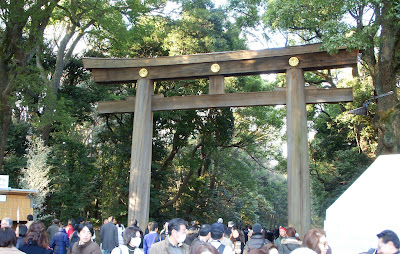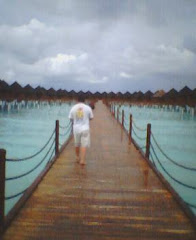

今日渋谷で韓国料理店の「ブールダック」で激旨料理食べる予定だったが、店に着いたら、週末にランチはやってない。作戦変更で前から気になってたタイラーメンの店に行ってきました。店の名前はタイ国ラーメン「ティーヌン」。ラーメンがメインですけどメニューにタイ料理の定番のレッドとグリーンカレーとか、チキンライスなどもあります。今日注文したのはトムヤムラーメン。スープは当たり前にすっぱ辛い。麺の量も多かったです。とっても美味しくいただきました。
Bon Appetit!
いただきます!
Life and Living in Tokyo, Japan


今日渋谷で韓国料理店の「ブールダック」で激旨料理食べる予定だったが、店に着いたら、週末にランチはやってない。作戦変更で前から気になってたタイラーメンの店に行ってきました。店の名前はタイ国ラーメン「ティーヌン」。ラーメンがメインですけどメニューにタイ料理の定番のレッドとグリーンカレーとか、チキンライスなどもあります。今日注文したのはトムヤムラーメン。スープは当たり前にすっぱ辛い。麺の量も多かったです。とっても美味しくいただきました。
Bon Appetit!
いただきます!


 [Ippudo] menu.
[Ippudo] menu.「一風堂」メニュー
Mikako ordered the shiromaru, while I ordered the akamaru.
 Shiromaru Moto Aji / 白丸元味
Shiromaru Moto Aji / 白丸元味 Akamaru Kasane Aji / 赤丸かさね味
Akamaru Kasane Aji / 赤丸かさね味 Bite-size Gyoza / 一口餃子
Bite-size Gyoza / 一口餃子 The Festival participants and float getting ready for the evening's parade.
The Festival participants and float getting ready for the evening's parade. The traditional clothing for the festival - I have my own at my mother-in-law's house.
The traditional clothing for the festival - I have my own at my mother-in-law's house. A closer look at the Nebuta (and yes it is lighted!).
A closer look at the Nebuta (and yes it is lighted!).東京のねぶた祭りに一つのねぶたしかなかったが、本場青森県で見ると20位のねぶたが出ますよ。見ると凄いしか言えない位迫力がある。日本の夏に来れたら、絶対見に行くべきの祭りです。
 Are these floats large or what?
Are these floats large or what? I can't wait to take my parents, sister, and brother-in-law to their first Nebuta Festival in Aomori which is the plan for this summer.
I can't wait to take my parents, sister, and brother-in-law to their first Nebuta Festival in Aomori which is the plan for this summer.早く自分の両親と妹夫妻を青森で初のねぶた祭りに連れてあげたい。今年の夏はそうゆう予定です!
 Very Cool!
Very Cool! If you look closely, especially below the blue and white sign, you will see that it takes a lot of manpower to move one of these floats.
If you look closely, especially below the blue and white sign, you will see that it takes a lot of manpower to move one of these floats. Passing through this torii, I will be on the grounds of Meiji Jingu Shrine.
Passing through this torii, I will be on the grounds of Meiji Jingu Shrine. Starting from top left to right:
Starting from top left to right:Hachinohe Senbei Jiru, [Aji no Sapporo] Miso Curry Milk Ramen, Goshogawara Razor Clam Ramen, Towada Pork Bowl
Kuroishi tsuyu yakisoba, Misawa hokkidon (hokki being a variety of clam), Shimokita kasamai yaki (Japanese beef skewers), Aomori style shoga-miso oden
Oominato Navy croquette, Fujigasawa chicken skewer, Goshogawara age tai, Namioka hot apple cider
 A wall of wine on the temple grounds. Why? Read the sign below.
A wall of wine on the temple grounds. Why? Read the sign below.ワインの樽はなぜ明治神宮に? 下記のサインを読んでみて。
 English version
English version Japanese version
Japanese version
 Otorii (Grand Shrine Gate) / 大鳥居
Otorii (Grand Shrine Gate) / 大鳥居 I thought I might have some time to check out the Meiji Jingu Garden (which has a small entrance fee) but then I noticed the sign that said there was a three hour wait. Needless to say, I skipped the gardens.
I thought I might have some time to check out the Meiji Jingu Garden (which has a small entrance fee) but then I noticed the sign that said there was a three hour wait. Needless to say, I skipped the gardens.まだ時間もあったから明治神宮御苑を探索しおうと思ったが(入場金は必要)でも入口に3時間待ちのサインを見て、ここも諦めました。
 Finally nearing Meiji Jingu Shrine - its quite a walk from the entrance.
Finally nearing Meiji Jingu Shrine - its quite a walk from the entrance.明治神宮にやっと近づきました、入口から結構歩きます。
 The Gate I just passed through.
The Gate I just passed through.先通った門。
 Meiji Jingu Shrine comes into view.
Meiji Jingu Shrine comes into view.明治神宮にやっとたどり着いた。
 This is the crowd on a Saturday - imagine this times 10 for hatsumode on New Year's Day.
This is the crowd on a Saturday - imagine this times 10 for hatsumode on New Year's Day.これは普通の土曜日。初詣が10倍位の参拝客が訪れると考えると。。。凄いしか思えない。
 The crowd didn't dwindle one bit after I paid my respects.
The crowd didn't dwindle one bit after I paid my respects.自分が参拝した後に次々と参拝客が来る。
 I still had another hour or so before the Aomori Nebuta Festival in Tokyo would start. But at 4pm, there was a short program before the festival began. I decided to stick around and watch it.
I still had another hour or so before the Aomori Nebuta Festival in Tokyo would start. But at 4pm, there was a short program before the festival began. I decided to stick around and watch it.青森ねぶた祭り イン 東京はあと1時間ほどだったので、4時位に明治神宮にてねぶたの出陣式が行われた。それを見ることにしました。
 Heading back to where the people are, I came across a sun dial.
Heading back to where the people are, I came across a sun dial. There is an area of Yoyogi Park and Meiji Jingu Shrine that's fenced off to the public, it is land dedicated to a bird sanctuary.
There is an area of Yoyogi Park and Meiji Jingu Shrine that's fenced off to the public, it is land dedicated to a bird sanctuary. Another view of part of the bird sanctuary.
Another view of part of the bird sanctuary. The species of birds you are most likely to see. I'm not going to bother finding out what the English names are - the pictures should suffice.
The species of birds you are most likely to see. I'm not going to bother finding out what the English names are - the pictures should suffice. Sign explaining why the bird sanctuary was created. I'm not going to translate the entire sign.
Sign explaining why the bird sanctuary was created. I'm not going to translate the entire sign. Another interesting piece of art. This is called "Quetzacoatl" by Frederico Silva. Presented as a gift to Japan from the Republic of Mexico.
Another interesting piece of art. This is called "Quetzacoatl" by Frederico Silva. Presented as a gift to Japan from the Republic of Mexico. I love checking out the various monuments and art pieces in public parks. This one is called "Shiawase no Zo" which translates to "The Statue of Happiness".
I love checking out the various monuments and art pieces in public parks. This one is called "Shiawase no Zo" which translates to "The Statue of Happiness". Another interesting bit of history in Yoyogi Park. This area is a sample garden created in 1964 when the Olympics were held in Tokyo. Read the sign for more details (even though I'm not sure if you can enlarge the picture).
Another interesting bit of history in Yoyogi Park. This area is a sample garden created in 1964 when the Olympics were held in Tokyo. Read the sign for more details (even though I'm not sure if you can enlarge the picture). Trees from around the world that were planted during the 1964 Tokyo Olympics.
Trees from around the world that were planted during the 1964 Tokyo Olympics. There is more history to Yoyogi Park than I thought. The area around this park was also used as the 1964 Olympic's Athlete's Village. The athletes stayed in little bungalows like this. This is one of the remaining buildings that was used by the athletes from the Netherlands. Short translation of the sign below.
There is more history to Yoyogi Park than I thought. The area around this park was also used as the 1964 Olympic's Athlete's Village. The athletes stayed in little bungalows like this. This is one of the remaining buildings that was used by the athletes from the Netherlands. Short translation of the sign below. 上の写真に関する説明。
上の写真に関する説明。It was time to leave the park and head towards Meiji Jingu Shrine where one of the Aomori Prefecture's Nebuta float is being displayed.
公園をあとにして、次は明治神宮を目指す。入口の前に青森県のねぶたが展示されてるのでそれを見に行った。
 Aomori Prefecture Nebuta Float / 青森県のねぶた
Aomori Prefecture Nebuta Float / 青森県のねぶた

この写真を見るとねぶたの大きさがちょっと分かると思う。
Time to check out Meiji Jingu Shrine and the Aomori Prefecture Food Booth Court.
これから明治神宮と青森産の屋台村を見に行く予定。
To be continued...
つづく。。。
 What's this? Its an art piece called "Fragment of the Horizon" by Shinji Kikuchi.
What's this? Its an art piece called "Fragment of the Horizon" by Shinji Kikuchi. Store sign for a Chinese restaurant called "Wang's Kitchen".
Store sign for a Chinese restaurant called "Wang's Kitchen".中華料理店「ワンズキッチェン」の看板。
 Symbol Monument for the Salt and Tobacco Museum (yes, there really is such a museum).
Symbol Monument for the Salt and Tobacco Museum (yes, there really is such a museum).たばこと塩の博物館のシンボルモニュメント (本当にそうゆう博物館がありますよ)。
 Entrance to the Tobacco and Salt Museum.
Entrance to the Tobacco and Salt Museum. As I headed towards Yoyogi Park, I came across a demo in progress.
As I headed towards Yoyogi Park, I came across a demo in progress. Walking inside Yoyogi Park.
Walking inside Yoyogi Park. First I checked out the most popular area of the park - the Great Fountain.
First I checked out the most popular area of the park - the Great Fountain. A monument commemorating Japan's first flight (or so the sign says). In a previous post, I had come across the Birthplace of Aviation in Japan which is located in Tokorozawa.
A monument commemorating Japan's first flight (or so the sign says). In a previous post, I had come across the Birthplace of Aviation in Japan which is located in Tokorozawa.
 I decided to walk around the less popular part of the park. As you can see, there were not many people around.
I decided to walk around the less popular part of the park. As you can see, there were not many people around. I think I stumbled across one of the reasons this side of the park isn't that popular. Deep inside the park is a tent village of homeless people. Something the Japanese government doesn't want to advertise to the world. Yes, even Japan has a homeless problem.
I think I stumbled across one of the reasons this side of the park isn't that popular. Deep inside the park is a tent village of homeless people. Something the Japanese government doesn't want to advertise to the world. Yes, even Japan has a homeless problem. It feels like I'm taking a walk through the woods.
It feels like I'm taking a walk through the woods.森の中で散歩してるみたい。
To be continued...
つづく。。。


